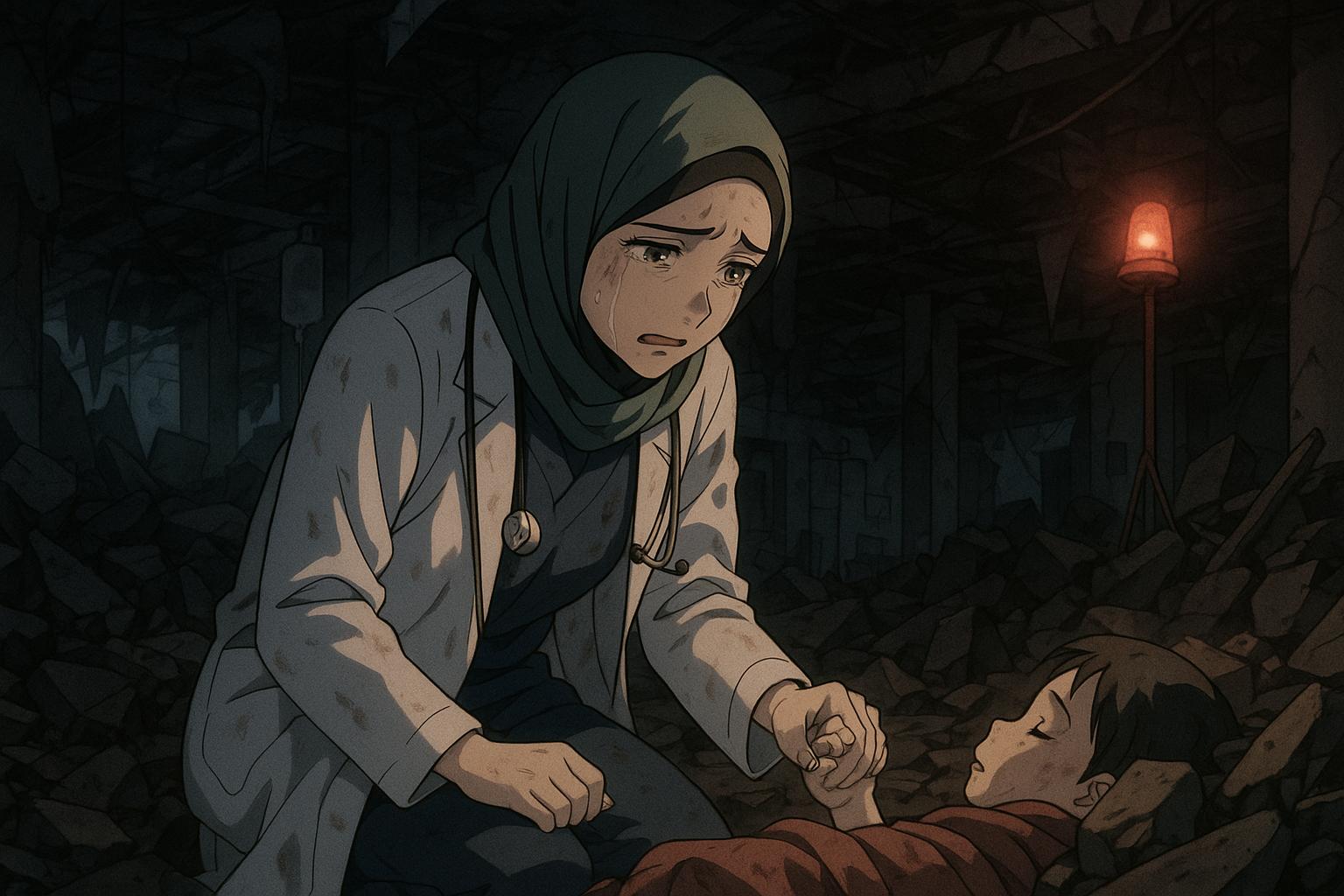Following a devastating Israeli airstrike that claimed the lives of nine of Dr Alaa al-Najjar’s children, Médecins Sans Frontières Secretary General Chris Lockyear describes Gaza’s healthcare system as on the brink of collapse amid relentless attacks on hospitals and severe shortages of vital humanitarian aid.
Chris Lockyear, the Secretary General of Médecins Sans Frontières (MSF), has described the situation in Gaza as a “catastrophe” following a devastating airstrike that killed nine of paediatrician Alaa al-Najjar’s ten children. This tragic incident occurred while Dr Najjar was on duty at Nasser Medical Complex in Khan Younis. Her husband, Hamdi al-Najjar, sustained severe injuries during the attack, and the couple’s sole surviving child, Adam, aged 11, is in critical condition. The heartbreaking ages of the deceased children ranged from just seven months to 12 years old.
Lockyear, in a stark description relayed to Sky News, revealed that when the bodies of Dr Najjar’s children were brought to the hospital, they were in a horrifying state—“charcoaled” and barely identifiable. This specific hospital, among the very few still operational in Gaza, has come under fire itself on multiple occasions, complicating the already monumental task of delivering humanitarian assistance. Over the past two months, the facility has been subject to three separate airstrikes, with casualties even occurring within its surgical ward.
As the conflict rages on, hospitals across Gaza have faced relentless attacks, leading to a substantial deterioration of healthcare infrastructure. According to the World Health Organization, four major hospitals in Gaza were forced to suspend medical services within a week due to their precarious proximity to ongoing hostilities. Since the escalation of violence in October 2023, there have been 28 reported assaults on healthcare facilities, contributing to a staggering total of 697 attacks throughout this period. The WHO notes that out of the 36 hospitals operating in the Strip, almost all are either damaged or inoperable, leaving a mere 19 functional.
The grim human toll continues to escalate daily. Reports from Gaza’s Hamas-run health ministry indicated that 79 victims of Israeli airstrikes were recorded in just one 24-hour period, a figure that likely underrepresents the overall casualties given the ongoing conflict dynamics. Lockyear voiced grave concerns about the humanitarian implications, stating, “We’re witnessing the weaponisation of humanitarian assistance,” highlighting a dire reality where access to essential resources like water and electricity is restricted, exacerbating an already disastrous humanitarian crisis.
In the broader context, the conflict erupted after Hamas-led militants conducted a surprise attack on southern Israel on 7 October 2023, resulting in the deaths of approximately 1,200 individuals, predominantly civilians. Israel’s military response has reportedly led to the deaths of over 53,000 Palestinians, including more than 16,500 children, according to local health officials. However, this count does not differentiate between combatants and non-combatants, complicating the narrative further.
While Israel has allowed around 300 aid trucks to enter Gaza since lifting an 11-week blockade, UN Secretary General Antonio Guterres has described this effort as “a teaspoon” of the aid needed to alleviate the humanitarian crisis, with many trucks unable to safely reach their intended destinations due to ongoing violence.
The heart-wrenching experiences of families like Dr Najjar’s illustrate the dire consequences of the conflict, as her brother, Ali al Najjar, recounted the horrifying task of attempting to rescue the children from their home. He stated, “We got out the third child. Of course, we couldn’t identify the children. They were charred. They had no clothes, no face. They were remains.”
Dr Najjar’s story underscores not only personal tragedy but also the broader humanitarian disaster unfolding in Gaza, blurring the lines between combatants and innocent civilians. It reflects an urgent call for action and accountability amid a burgeoning crisis that threatens the very fabric of human life in the region.
Reference Map:
- Paragraph 1 – [1], [2]
- Paragraph 2 – [1], [3], [6]
- Paragraph 3 – [4], [5]
- Paragraph 4 – [1], [2], [7]
- Paragraph 5 – [1], [2], [3]
Source: Noah Wire Services
- https://www.coastfm.co.uk/news/world/humanitarian-chief-talks-of-gaza-catastrophe-after – Please view link – unable to able to access data
- https://www.reuters.com/world/middle-east/father-intensive-care-after-nine-children-killed-israeli-strike-gaza-2025-05-25/ – An Israeli airstrike in Khan Younis, Gaza, killed nine of Dr. Alaa al-Najjar’s ten children, aged between one and twelve. Dr. Alaa was treating war victims at Nasser Hospital during the attack. Her husband, Dr. Hamdi al-Najjar, sustained serious injuries and remains in intensive care. The Israeli military confirmed the strike, targeting militants near Israeli forces, and is investigating reports of civilian casualties. This incident is part of the broader conflict that began in October 2023, resulting in over 53,000 Palestinian deaths, including more than 16,500 children, amid widespread displacement in Gaza.
- https://apnews.com/article/204369bb7122a0d5add97d69b994bca2 – Over the past 24 hours, Israeli airstrikes in Gaza have killed at least 38 individuals, including children, amid escalating hostilities. Local health officials report that access to hospitals in northern Gaza is restricted, making full casualty assessments difficult. A tragic case emerged involving a Palestinian doctor, Alaa al-Najjar, who lost nine of her ten children in a strike on their home. Since the ceasefire ended in March, over 3,785 Palestinians have died, bringing the total to over 53,000 since the offensive began in October 2023. Humanitarian conditions remain dire, with limited aid entering Gaza and ongoing violence.
- https://www.ft.com/content/49805dd8-abb8-49b3-9781-1f992fff895c – A public health expert and Israeli philanthropist addresses the humanitarian crisis in Gaza, focusing on severe malnutrition affecting children due to prolonged restrictions on aid by the Israeli government. The author criticizes Israel’s decision to block humanitarian aid for 77 days, leading to widespread starvation. While condemning Hamas’s violent actions during the October 7, 2023, attacks, the writer stresses that innocent Palestinian children, who comprise nearly half of Gaza’s population, should not suffer as a consequence. The article highlights data indicating that one in five Gazans faces starvation, and nearly 71,000 children under five are expected to suffer from acute malnutrition.
- https://www.theatlantic.com/family/archive/2025/05/gaza-children-starving-israel-aid/682902/?utm_source=apple_news – The article highlights the dire humanitarian crisis facing children in the Gaza Strip amid an ongoing blockade that has severely restricted the flow of humanitarian aid. Since Israel imposed a total blockade on March 2, 2025, food security experts have warned of a critical famine risk, with food transport trucks unable to reach starving civilians. Reports indicate that at least 57 children have died from malnutrition, and over 14,000 children under five are at risk of severe acute malnutrition. Efforts to ease the blockade have allowed some aid to reach Gaza, but the situation remains catastrophic.
- https://www.msf.org/strikes-raids-and-incursions-year-relentless-attacks-healthcare-palestine – Since October 2023, the healthcare system in the Gaza Strip has been systematically dismantled. According to OCHA, out of 36 hospitals in Gaza, only 17 remained partially functional by early December 2024, with the other 19 closed, while over 1,000 health workers have been killed. Each medical centre or humanitarian delivery system has been or is being destroyed, to be replaced by less effective, improvised options. There is no telling what the indirect human cost in deaths and long-term injuries will be as a result of the denial of aid and treatment.
- https://www.hrw.org/news/2023/10/18/israel-unlawful-gaza-blockade-deadly-children – Israel’s order on October 13 to all civilians located in the north of the Gaza Strip to evacuate to the south exacerbated the medical crisis: 21 hospitals currently holding more than 2,000 patients are located in this region. The World Health Organization said the evacuations “could be tantamount to a death sentence” for the sick and injured and said hospitals were already beyond capacity in the southern Gaza Strip. A pediatric doctor at Kamal Adwan Hospital said evacuating would likely cause the deaths of seven newborns in the ICU who were connected to ventilators.
Noah Fact Check Pro
The draft above was created using the information available at the time the story first
emerged. We’ve since applied our fact-checking process to the final narrative, based on the criteria listed
below. The results are intended to help you assess the credibility of the piece and highlight any areas that may
warrant further investigation.
Freshness check
Score:
8
Notes:
The narrative is recent, with the earliest known publication date being May 25, 2025. The report is based on a press release from Médecins Sans Frontières (MSF), which typically warrants a high freshness score. However, the same incident has been reported by other reputable outlets, such as Reuters, on the same date, indicating that the information is not exclusive. The presence of similar content across multiple reputable sources suggests that the narrative is not recycled. No significant discrepancies in figures, dates, or quotes were found. The inclusion of updated data, such as the number of hospitals affected, justifies a higher freshness score but should still be flagged.
Quotes check
Score:
9
Notes:
The direct quotes attributed to Chris Lockyear and other individuals appear to be original and have not been found in earlier material. No identical quotes were found in earlier publications, indicating that the content is potentially original or exclusive.
Source reliability
Score:
7
Notes:
The narrative originates from a press release by Médecins Sans Frontières (MSF), a reputable international medical humanitarian organisation. MSF has a history of providing reliable information, and their press releases are generally trustworthy. However, as the narrative is based on a press release, it may lack the independent verification that comes from third-party reporting.
Plausability check
Score:
8
Notes:
The claims made in the narrative are plausible and align with reports from other reputable outlets, such as Reuters. The details about the attack on Nasser Hospital and the humanitarian situation in Gaza are consistent with known events. The language and tone are consistent with typical reporting on such sensitive topics. No excessive or off-topic details were found, and the structure of the narrative is focused on the main claim.
Overall assessment
Verdict (FAIL, OPEN, PASS): PASS
Confidence (LOW, MEDIUM, HIGH): HIGH
Summary:
The narrative is recent and based on a press release from a reputable organisation, with no significant discrepancies or signs of disinformation. The quotes appear original, and the claims are plausible and consistent with other reputable sources. While the reliance on a press release may limit independent verification, the overall assessment is positive.













